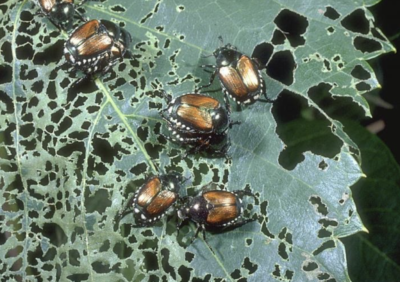Japanese beetles are aggressive eaters that ruin the plants appearance and cause unnecessary stress? Multiple insecticide applications are necessary to minimize the damage. Here is an article and from the University of Missouri explaining this damaging pest. We can put into place an Integrated Pest Management solution to protect your plants health.
Here is an article written by the Editors at the The Old Farmers Alamanac describing the Japanese beetle.
Japanese beetles (Popillia japonica) are small insects that carry a big threat. They do not discriminate when it comes to what types of plants they feed on, though they do have favorites (like roses). In fact, they are classified as a pest to hundreds of different species. They are one of the major insect pests in the Eastern and Midwestern United States, causing monumental damage to crops each year.
Prior to the beetle’s accidental introduction to the United States in the early 1900s, the Japanese beetle was found only on the islands of Japan, isolated by water and kept in check by its natural predators. In 1912, a law was passed that made it illegal to import plants rooted in soil. Unfortunately, the failure to implement the law immediately allowed the Japanese beetle to arrive in this country.
Most entomologists agree that the beetles entered the country as grubs in soil on Japanese iris roots. In 1916, these coppery-winged pests were first spotted in a nursery near Riverton, New Jersey, and by 1920, eradication programs were dropped; the beetle proved to be too prolific and widespread.
IDENTIFICATION
HOW TO IDENTIFY JAPANESE BEETLES
Japanese Beetles are ½ inch in length with metallic blue-green heads, copper-colored backs, tan wings, and small white hairs lining each side of the abdomen. Japanese beetles usually feed in small groups. They lay eggs in the soil during June, which develop into tiny white grubs with brown heads and six legs that are up to ¾ inch in length. These grubs will remain underground for about 10 months, overwintering and growing in the soil.
They emerge from the soil as adult beetles and begin feeding the following June. They usually attack plants in groups, which is why damage is so severe. Although the lifecycle of the adult Japanese beetle is barely 40 days, it can cover a lot of ground. Even if you succeed in controlling your Japanese beetle population, your neighbor’s Japanese beetles might come on over.
 Photo Credit: Ohio State University. Japanese beetles cause leaves to appear skeletonized.
Photo Credit: Ohio State University. Japanese beetles cause leaves to appear skeletonized.
SIGNS OF JAPANESE BEETLE DAMAGE
Japanese beetles feed on a wide variety of flowers and crops (the adult beetles attack more than 300 different kinds of plants), but in terms of garden plants, they are especially common on roses, as well as beans, grapes, and raspberries. Here’s what to look out for:
Skeletonized Leaves and Flowers
Japanese beetles can devour most of the foliage on favored plants, as well as the flowers. Look for leaves that are “skeletonized” (i.e., only have veins remaining). This is a tell-tale sign of Japanese beetles. Japanese beetles are not usually far from damaged leaves, so inspect the plant thoroughly. Also keep an eye on the ground beneath the plant; the beetles may reflexively drop off the plant if disturbed.
